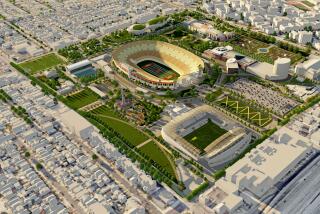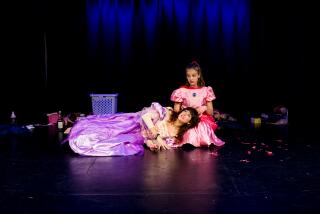There’s Lots of Life After Expo Around Vancouver
- Share via
VANCOUVER, Canada — When the gates close Monday to mark the end of Expo, more than 20 million people from around the world will have passed through them since May 2 to set one of many records for what will likely will go down in history as the most successful of all world expositions.
A tabulation after last past weekend showed that Expo 86 had already passed attendance records of the last world’s fair in Japan, which registered 20.3 million visitors. Back in 1967 the Montreal Expo attracted 50 million visits, but in many ways did not blaze the new trails of the Vancouver Expo. By contrast, the Knoxville Expo drew 11.1 million visitors in 1982. New Orleans had 7.3 million in 1984.
Last week, when attendance was expected to be winding down because summer vacations were over, my wife and I were two of nearly 134,000 visitors making our way through the gates and patiently waiting in long lines to get into the most popular pavilions. Hotels and guest houses were still solidly booked. Attendance is expected to continue at summertime levels right on through Monday.
So what happens next? A tranquil autumn and winter during which everyone connected with tourism to Vancouver and British Columbia can relax after 165 days of Expo and the years of preparation for it?
World Highlight
Not quite.
“This has been a once-in-a-lifetime opportunity,” says Dave Henderson, director of marketing services for Tourism British Columbia, “and we’re not going to let a moment of it pass by. We believe that we have a brand-new product to offer to the world as a result of Expo.”
The U.S., Soviet Union and People’s Republic of China pavilions, sharing the same world exposition for the first time, were undoubtedly the world highlight of the Expo, but at the bottom line of travel economics California was reaffirmed as the most important single market for the future of British Columbia tourism.
Until Expo, Tourism B.C. had concentrated its efforts on the natural wonders of the province from the Rockies to the Strait of Georgia, Vancouver Island and the Sunshine Coast. Now the spotlight will also be on the cultural attractions that were brought to center stage by Expo 86. For Vancouver in particular, it will recall to Expo visitors the natural attractions that they may not have had enough time to explore.
The more than 100,000 people a day who have visited Expo this autumn have been enchanted by the nearby fall foliage. Vine maple leaves have turned first along the streets to Expo, and now other trees are beginning to glow.
Summer events such as hang gliding over the slopes of Grouse Mountain above Vancouver made the point for Expo visitors that downtown dinner and an evening at the opera were only 15 minutes from an afternoon of downhill skiing.
Research shows that the majority of visitors to Expo bought three-day passes and that many had planned to visit here for six days. This gave them a chance to see the parks, waterways and mountains that are part of the metropolitan area.
Throughout Expo, Tourism B.C. marketing people quietly made contact with 800 people who were first-time visitors. Now each of them has been contacted by phone about their impressions of Vancouver and British Columbia, and what they would like to see and do on a return visit.
Travel Theme
As a result of their enthusiastic responses, the new tourism campaign, to be introduced in California, will blend the cultural side of the Vancouver, Victoria and British Columbia experience with this province’s natural attributes.
This will be the travel theme for all seasons. It will feature artistic, literary, folk art, social and historical displays, along with museums, theater, opera, symphony and ballet, as counterpoints to boating, hiking, skiing, golf, tennis, spectator sports and just generally enjoying nature. Bimonthly schedules of events will be available through travel agents, airlines and Tourism B.C. offices. Contact Tourism British Columbia at 3400 Wilshire Blvd., Los Angeles 90010, phone (213) 380-9171.
The schedules will list events in Vancouver and around British Columbia. The Vancouver Symphony Orchestra series, for example, will run from next Sunday through May 5, featuring a classical range from Sibelius, Strauss, Schubert and Mozart to Beethoven, Liszt and Tchaikovsky.
The Vancouver Opera season from October into May has scheduled performances that include “The Marriage of Figaro,” “Madame Butterfly” and “Lucia de Lammermoor.” The theater season at the Vancouver Playhouse during the same season starts off with “Paracelsus” and goes on through “The Diary of Anne Frank” to such favorites as “Private Lives” and “Are You Lonesome Tonight?”
An Image-Builder
Throughout Expo, the World Festival of Performing Arts, presenting 200 performances by some of the world’s greatest concert, symphony, ballet and solo performers, helped to build the image of Vancouver as a cultural destination.
As soon as its slopes are snow-covered, Grouse Mountain will be ready with day and night skiing, which can be planned around dinner at the Grouse Nest restaurant and its mountaintop views of the city and harbor. The Canadian Masters Alpine Series Slalom Race is set for Jan. 17-18. Lift tickets for adults will be $22 all day and $18 for night skiing.
Four double chairlifts and two aerial tramways, two T-bars and three rope tows serve the 11 runs, the longest of which is more than a mile with a vertical drop of 1,200 feet. Twenty percent of the runs are for advanced skiers, 50% for intermediates and 30% for beginners.
Seymour and Cypress, two other popular ski areas above Vancouver, are under private management and have been expanding their facilities for the upcoming season. The Whistler and Blackcomb ski slopes two hours north of Vancouver have a network of more than 100 runs combining nearly 10,000 vertical feet of skiing, highest total on the continent.
The enhanced awareness all of these British Columbia winter sports areas have received as a result of Expo 86 will be given another boost from the ’88 Winter Olympics near Calgary in the adjacent province of Alberta.
Urban Transformation
Right after the Expo gates close, steps will begin to transform the sites into residential and shopping areas close to the heart of the city.
Several of the Expo facilities will become permanent tourism assets. Canada Place, a short sky-ride on the Tomorrow Train from the main Expo site, is part of an ultra-modern cruise ship terminal that can berth several ships at a time. Shaped like the famed Sydney Opera House against the dramatic backdrop of the Coast Mountains, it has been a technology showcase and Imax 3-D Theater during Expo. Now it will become the Vancouver Trade and Convention Center adjacent to the glassed-in restaurant and promenades of shops.
The Meridien is a new hotel of international stature among the many around downtown Vancouver and the harbor area. All of the hotels, inns and bed-and-breakfast houses of Vancouver, plus the restaurants of many ethnic cuisines that served millions of people during Expo, will be part of the program to bring back the visitors. Hotel and restaurant guides, with updated prices, will be included in new promotional materials at Tourism B.C. offices.
We’ve stood in lines during Expo’s last days and talked with visitors from throughout Canada and the United States and many other nations. We’ve walked with a sense of wonder from Hungary to Sri Lanka, Moscow and Peking, from Saudi Arabia to Switzerland and the pavilions of more than 100 international, corporate, Canadian provincial and U.S. state participants. We’ve even discovered a tiny and fascinating land we had missed before, Brunei Darussalam in Borneo, one of the world’s richest per-capita states.
Now we can’t leave Expo without feeling that the rest of the world will be returning to Vancouver and British Columbia during the coming years of tourism.
More to Read
Sign up for The Wild
We’ll help you find the best places to hike, bike and run, as well as the perfect silent spots for meditation and yoga.
You may occasionally receive promotional content from the Los Angeles Times.






